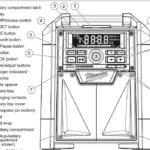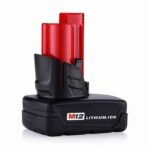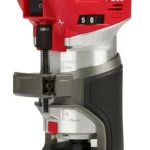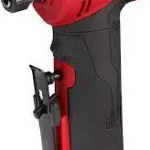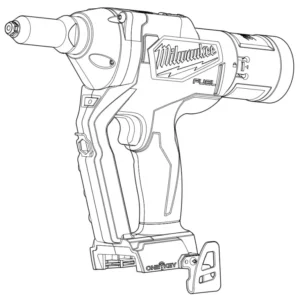
milwaukee M18 Fuel Rivet Tool

 WARNING
WARNING
 To reduce the risk of injury, user must read and understand operator’s manual.
To reduce the risk of injury, user must read and understand operator’s manual.
SAFTEY INSTUCTIONS
GENERAL POWER TOOL SAFETY WARNINGS
![]() Read all safety warnings, instructions, illustrations and specifications provided with this power tool.
Read all safety warnings, instructions, illustrations and specifications provided with this power tool.
Failure to follow all instructions listed below may result in electric shock, fire and/or serious injury.
Save all warnings and instructions for future reference.
The term “power tool” in the warnings refers to your mains-operated (corded) power tool or battery-operated (cordless) power tool.
WORK AREA SAFETY
- Keep work area clean and well lit. Cluttered or dark areas invite accidents.
- Do not operate power tools in explosive atmospheres, such as in the presence of flammable liquids, gases or dust. Power tools create sparks which may ignite the dust or fumes.
- Keep children and bystanders away while operating a power tool. Distractions can cause you to lose control.
ELECTRICAL SAFETY
- Power tool plugs must match the outlet. Never modify the plug in any way. Do not use any adapter plugs with earthed (grounded) power Unmodified plugs and matching outlets will reduce risk of electric shock.
- Avoid body contact with earthed or grounded surfaces, such as pipes, radiators, ranges and There is an increased risk of electric shock if your body is earthed or grounded.
- Do not expose power tools to rain or wet conditions Water entering a power tool will increase the risk of electric shock.
- Do not abuse the cord. Never use the cord for carrying, pulling or unplugging the power tool. Keep cord away from heat, oil, sharp edges or moving Damaged or entangled cords increase the risk of electric shock.
- When operating a power tool outdoors, use an ex- tension cord suitable for outdoor Use of a cord suitable for outdoor use reduces the risk of electric shock.
- If operating a power tool in a damp location is unavoidable, use a residual current device (RCD) protected supply. Use of a RCD reduces the risk of electric the risk of electric shock.
PERSONAL SAFETY
- Stay alert, watch what you are doing and use common sense when operating a power Do not use a power tool while you are tired or under the influence of drugs, alcohol or medication. A moment of inattention while operating power tools may result in serious personal injury.
- Use personal protective Always wear eye protection. Protective equipment such as a dust mask, non-skid safety shoes, hard hat or hearing protection used for appropriate conditions will reduce personal injuries.
- Prevent unintentional Ensure the switch is in the off-position before connecting to power source and/or battery pack, picking up or carrying the tool. Carrying power tools with your finger on the switch or energising power tools that have the switch on invites accidents.
- Remove any adjusting key or wrench before turning the power tool on. A wrench or a key left attached to a rotating part of the power tool may result in personal injury.
- Do not Keep proper footing and balance at all times. This enables better control of the power tool in unexpected situations.
- Dress properly. Do not wear loose clothing or Keep your hair and clothing away from moving parts. Loose clothes, jewellery or long hair can be caught in moving parts.
- If devices are provided for the connection of dust extraction and collection facilities, ensure these are connected and properly used. Use of dust collection can reduce dust-related hazards.
- Do not let familiarity gained from frequent use of tools allow you to become complacent and ignore tool safety principles. A careless action can cause severe injury within a fraction of a second.
POWER TOOL USE AND CARE
- Do not force the power Use the correct power tool for your application. The correct power tool will do the job better and safer at the rate for which it was designed.
- Do not use the power tool if the switch does not turn it on and Any power tool that cannot be controlled with the switch is dangerous and must be repaired.
- Disconnect the plug from the power source and/ or remove the battery pack, if detachable, from the power tool before making any adjustments, changing accessories, or storing power tools. Such preventive safety measures reduce the risk of starting the power tool
- Store idle power tools out of the reach of children and do not allow persons unfamiliar with the power tool or these instructions to operate the power Power tools are dangerous in the hands of untrained users.
- Maintain power tools and accessories. Check for misalignment or binding of moving parts, breakage of parts and any other condition that may affect the power tool’s If damaged, have the power tool repaired before use. Many accidents are caused by poorly maintained power tools.
- Keep cutting tools sharp and clean. Properly maintained cutting tools with sharp cutting edges are less likely to bind and are easier to control.
- Use the power tool, accessories and tool bits in accordance with these instructions, taking into account the working conditions and the work to be performed. Use of the power tool for operations different from those intended could result in a hazardous situation.
- Keep handles and grasping surfaces dry, clean and free from oil and grease. Slippery handles and grasping surfaces do not allow for safe handling and control of the tool in unexpected situations.
BATTERY TOOL USE AND CARE
- Recharge only with the charger specified by the A charger that is suitable for one type of battery pack may create a risk of fire when used with another battery pack.
- Use power tools only with specifically designated battery Use of any other battery packs may create a risk of injury and fire.
- When battery pack is not in use, keep it away from other metal objects, like paper clips, coins, keys, nails, screws or other small metal objects, that can make a connection from one terminal to Shorting the battery terminals together may cause burns or a fire.
- Under abusive conditions, liquid may be ejected from the battery; avoid If contact accidentally occurs, flush with water. If liquid contacts eyes, additionally seek medical help. Liquid ejected from the battery may cause irritation or burns.
- Do not use a battery pack or tool that is dam- aged or Damaged or modified batteries may exhibit unpredictable behavior resulting in fire explosion or risk of injury.
- Do not expose a battery pack or tool to fire or excessive temperature. Exposure to fire or temperature above 130°C (265°F) may cause explosion.
- Follow all charging instructions and do not charge the battery pack or tool outside the temperature range specified in the instructions. Charging improperly or at temperatures outside the specified range may damage the battery and increase the risk of fire.
SERVICE
- Have your power tool serviced by a qualified repair person using only identical replacement This will ensure that the safety of the power tool is maintained.
- Never service damaged battery packs. Service of battery packs should only be performed by the manufacturer or authorised service providers.
SPECIFIC SAFETY RULES FOR RIVET TOOL
- Hold the power tool by insulated gripping surfaces when performing an operation where the fastener may contact hidden Fasteners contacting “live” wire may make exposed metal parts of the power tool “live” and could dive the operator an electric shock.
- Always use mandrel Spent mandrels can be ejected from the tool, causing injury.
- Chemical Burn Hazard. Keep coin cell battery away from
- Always use common sense and be cautious when using tools. It is not possible to anticipate every situation that could result in a dangerous Do not use this tool if you do not understand these operating instructions or you feel the work is beyond your capability; contact MILWAUKEE® Tool or a trained professional for additional information or training.
- Maintain labels and nameplates. These carry important information. If unreadable or missing, contact a MILWAUKEE® service facility for a replacement.
 Some dust created by power sanding, sawing, grinding, drilling, and other construction activities contains chemicals known to cause cancer, birth defects or other reproductive harm. Some examples of these chemicals are:
Some dust created by power sanding, sawing, grinding, drilling, and other construction activities contains chemicals known to cause cancer, birth defects or other reproductive harm. Some examples of these chemicals are: - lead from lead-based paint
- crystalline silica from bricks and cement and other masonry products, and
- arsenic and chromium from chemically-treated lumber.
Your risk from these exposures varies, depending on how often you do this type of work. To reduce your exposure to these chemicals: work in a well ventilated area, and work with approved safety equipment, such as those dust masks that are specially designed to filter out microscopic particles.
ADDITIONAL BATTERY SAFETY RULES
![]() To reduce the risk of fire, personal injury, and product damage due to a short circuit, never immerse your tool, battery pack or charger in fluid or allow a fluid to flow inside them. Corrosive or conductive fluids, such as seawater , certain industrial chemicals, and bleach or bleach-containing products, etc., can cause a short circuit.
To reduce the risk of fire, personal injury, and product damage due to a short circuit, never immerse your tool, battery pack or charger in fluid or allow a fluid to flow inside them. Corrosive or conductive fluids, such as seawater , certain industrial chemicals, and bleach or bleach-containing products, etc., can cause a short circuit.
![]() Do not charge non-rechargeable batteries.
Do not charge non-rechargeable batteries.
SYMBOLOGY
 |
Volts |
 |
Direct Current |
 |
Read Operator’s Manual |
 |
Always wear eye protection |
 |
Wear gloves. |
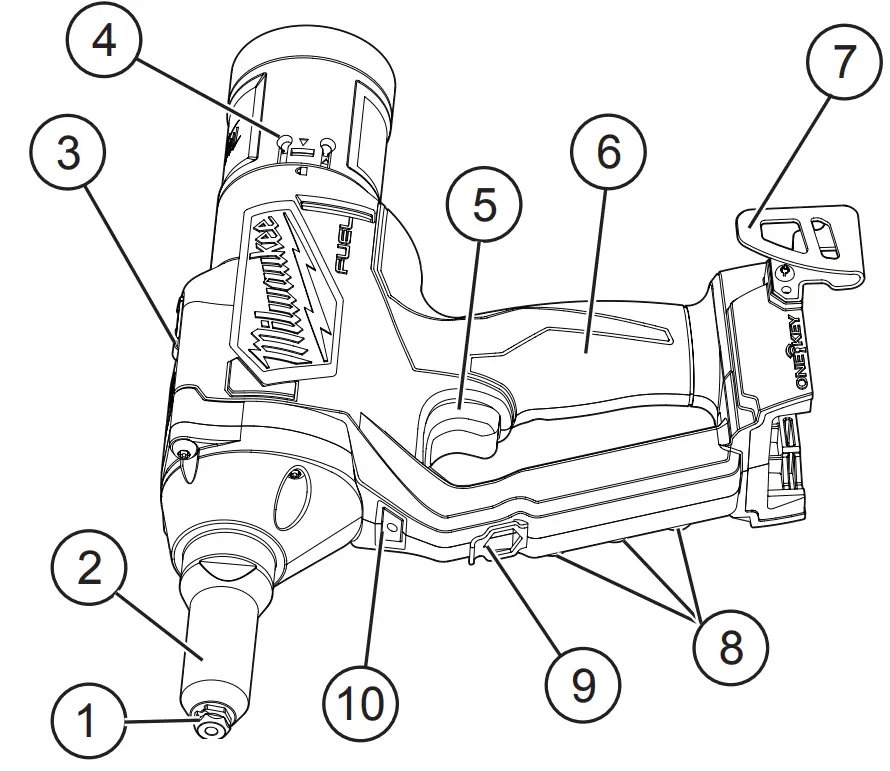 |
Regulatory Compliance Mark (RCM). This product meets applicable regulatory requirements. |
 |
Do not dispose of electric tools together with household waste material. Electric tools and electronic equipment that have reached the end of their life must be collected separately and returned to an environmentally compatible recycling facility. |
SPECIFICATIONS
| Cat. No. | M18 FPRT |
| Volts | 18V DC |
| Battery Type | M18™ |
| Charger Type | M18™ |
| Blind Rivet Sizes | 3/16″ (4.76mm), 7/32″ (5.56mm), 1/4″ (6.35mm), 9/32″ (7.14mm) |
| Recommended Ambient | |
| Operating Temperature | 0°C to 51°C |
FUNCTIONAL DESCRIPTION

- Nose piece
- Nose housing
- Tool hanger
- Mandrel collector
- Trigger
- Handle
- Belt hook
- Nose piece storage
- Wrench
- LED
ASSEMBLY
Recharge only with the charger specified for the battery. For specific charging instructions, read the operator’s manual supplied with your charger and battery.
Removing/Inserting the Battery
![]() To remove the battery, push in the release buttons and pull the battery pack away from the tool.
To remove the battery, push in the release buttons and pull the battery pack away from the tool.
![]() Always lock the trigger or remove the battery pack any time the tool is not in use.
Always lock the trigger or remove the battery pack any time the tool is not in use.
To insert the battery, slide the pack into the body of the tool. Make sure it latches securely into place.
![]() Only use accessories specifically recommended for this tool. Others may be hazardous.
Only use accessories specifically recommended for this tool. Others may be hazardous.
Always use mandrel box. Spent mandrels can be ejected from the tool, causing injury.
Once the rivet is set, the mandrel collects in the box. Empty the mandrel box often to avoid jamming the tool.
![]() Never use the tool without the mandrel box installed. Loose mandrels could cause a hazard.
Never use the tool without the mandrel box installed. Loose mandrels could cause a hazard.
- To install the mandrel box, line up the box with the detents in the tool. Slide the box onto the tool, and rotate to lock
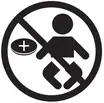 in place.
in place. - To empty the mandrel box, rotate the box and pull away from the tool. Empty the box and reinstall before use.
Installing the Nose Piece
The rivet tool comes with 4 nose pieces for 3/16″ (4.76mm), 7/32 (5.56mm), 1/4″ (6.35mm), and 9/32″ (7.14mm) blind rivet sizes.
- Remove battery pack.
- Remove the nose housing from the tool (recommended). NOTE: Due to the spring, it can be difficult to install the nose piece into the nose housing without first removing the nose housing.
- Remove the nose piece from the nose housing. For ease of use, the wrench does not need to be removed from the tool for use. Insert the nose housing into the onboard wrench storage and turn counterclockwise.

- Select the correct nose piece
for the rivet to be installed. To remove the nose piece from the on-tool storage, use your thumb to pull down on needed nose piece. - Insert the new nose piece into the nose housing.
Use the onboard wrench to hand-tighten securely. 6. Screw the nose housing onto the tool and hand tighten securely.Nose Piece Ring Color 3/16″ (4.76mm) Black 1/4″ (6.35mm) Green 7/32″ (5.56mm) Red 9/32″ (7.14mm) Brown
ONE-KEY™
To learn more about the ONE-KEY™ functionality for this tool, go to milwaukeetool.com/One-Key. To download the ONE-KEY™ app, visit the App Store or Google Play from your smart device.
| ONE-KEY™ Indicator | |
| Solid Blue | Wireless mode is active and ready to be configured via the ONE-KEY™ app. |
| Blinking Blue | Tool is actively communicating with the ONE-KEY™ app. |
| Blinking Red | Tool is in security lockout and can be unlocked by the owner via the ONE-KEY™ app. |
OPERATION
![]() To reduce the risk of injury wear proper eye protection marked , always to comply with AS/NZS 1337.1.
To reduce the risk of injury wear proper eye protection marked , always to comply with AS/NZS 1337.1.
Always remove battery pack before changing or removing accessories. Only use accessories specifically recommended for this tool. Others may be hazardous.
Always hold tool securely and anticipate a sudden reaction.
Using the Rivet Tool
- Prepare the workpiece. If necessary, drill a pilot hole.
- Place the blind rivet mandrel into the nose piece.

- Insert the rivet end into the workpiece. Hold the tool securely and pull and hold the trigger until the rivet is fully set and the motor stops.
Release the trigger. The tool will reset.

NOTE: Releasing the trigger before the rivet is fully set will cause the tool to return to its starting position. - Tip the tool back to clear the mandrel. It will slide into the mandrel box.
- Empty the mandrel box after setting 100-150 rivets, depending on size.

MAINTENANCE
![]() To reduce the risk of injury, always unplug the charger and remove the battery pack from the charger or tool before performing any maintenance. Never disassemble the tool, battery pack or charger. Contact a MILWAUKEE® service facility for ALL repairs.
To reduce the risk of injury, always unplug the charger and remove the battery pack from the charger or tool before performing any maintenance. Never disassemble the tool, battery pack or charger. Contact a MILWAUKEE® service facility for ALL repairs.
Maintaining Tool
Keep your tool, battery pack and charger in good repair by adopting a regular maintenance program.
Inspect your tool for issues such as undue noise, misalignment or binding of moving parts, breakage of parts, or any other condition that may affect the tool operation. Return the tool, battery pack, and charger to a MILWAUKEE® service facility for repair.
After six months to one year, depending on use, return the tool, battery pack and charger to a MILWAUKEE® service facility for inspection. If the tool does not start or operate at full power with a fully charged battery pack, clean the contacts on the battery pack. If the tool still does not work properly, return the tool, charger and battery pack, to a MILWAUKEE® service facility for repairs.
Cleaning/Lubricating
Clean and lubricate the nose of the tool after heavy use (5000 rivets) or if tool becomes contaminated with dust and debris.
- Remove battery pack.
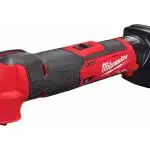
- Remove the nose housing from the tool and the nose piece from the housing.
- Remove the guide (with jaws), pusher tube, and spring from the tool.
- Clean all pieces with a dry cloth and inspect for damage. If damaged, return to a MILWAUKEE® service facility for repairs.
- Apply a small amount of oil to the pieces and reassemble, as shown. Ensure the jaws are properly seated in the guide.
ONE-KEY™
![]() Chemical Burn Hazard.
Chemical Burn Hazard.
This device contains a lithium button/coin cell battery. A new or used battery can cause severe internal burns and lead to death in as little as 2 hours if swallowed or enters the body. 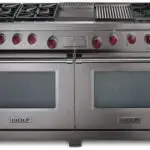
Always secure the battery cover. If it does not close securely, stop using the device, remove the batteries, and keep it away from children. If you think batteries may have been swallowed or entered the body, seek immediate medical attention.
Internal Battery
An internal battery is used to facilitate full ONE-KEY™ functionality.
To replace the battery:
- Remove the battery pack.
- Remove the screw(s) and open the battery door.
- Remove the old battery, keep it away from children, and dispose of it properly.
- Insert the new battery (3V CR2032), with the positive side facing up.
- Close the battery door and tighten the screw(s) securely.
![]() To reduce the risk of personal injury and damage, never immerse your tool, battery pack or charger in liquid or allow a liquid to flow inside them.
To reduce the risk of personal injury and damage, never immerse your tool, battery pack or charger in liquid or allow a liquid to flow inside them.
Cleaning
Clean dust and debris from any vents. Keep tool clean, dry and free of oil or grease. Use only mild soap and a damp cloth to clean, since certain cleaning agents and solvents are harmful to plastics and other insulated parts. Some of these include gasoline, turpentine, lacquer thinner, paint thinner, chlorinated cleaning solvents, ammonia and household detergents containing ammonia. Never use flammable or combustible solvents around tools.
Repairs
For repairs, return the tool, battery pack and charger to the nearest authorised service centre.
ACCESSORIES
![]() Use only recommended accessories. Others may be hazardous.
Use only recommended accessories. Others may be hazardous.
For a complete listing of accessories, go online to milwaukeetool.com.au/ milwaukeetool.co.nz or contact a distributor
WARRANTY
WARRANTY – AUSTRALIA and NEW ZEALAND
Please refer to Australian and New Zealand warranty supplied with tool. This warranty applies only to product sold by authorised dealers in Australia and New Zealand.
SERVICE – AUSTRALIA and NEW ZEALAND
MILWAUKEE® prides itself in producing a premium quality product that is Nothing But Heavy DutyTM.
Your satisfaction with our products is very important to us! If you encounter any problems with the operation of this tool, please contact your authorised MILWAUKEE® dealer.
For a list of MILWAUKEE® dealers, guarantee or service agents please contact MILWAUKEE®
Customer Service or visit our website.
(Australia Toll Free Telephone Number 1300 645 928) (New Zealand Toll Free Telephone Number 0800 645 928) or visit milwaukeetool.com.au/milwaukeetool.co.nz
Milwaukee Electric Tool Corporation
13135 West Lisbon Road, Brookfield, Wisconsin U.S.A. 53005
Milwaukee Tool (Australia)
21 Kelletts Road, Rowville, VIC 3178
Melbourne, Australia
Milwaukee Tool (New Zealand)
274 Church Street, Penrose,
Auckland, 1061, New Zealand
DESIGNED BY MILWAUKEE ELECTRIC TOOL CORP.
PROFESSIONALLY MADE IN CHINA
PRINTED IN CHINA
